7.1 Computer management tasks
|
Previous
Chapter 6: Electronic communications
|
Next
Chapter 8: The internet and the world-wide web
|
 CHAPTER OVERVIEW
CHAPTER OVERVIEW
| Unit 7.1 | Computer management tasks |
 Learning outcomes
Learning outcomes
At the end of this chapter you should be able to:
- describe computer management and its maintenance
- list and describe different computer management tasks and the utilities used.
INTRODUCTION
When you get something new, everything is clean, it looks fantastic, it works well, and it even smells good! You want to show all your friends because you are excited.

This feeling usually lasts for about a few months and then you might start noticing a few problems ...
The same can be true when you get a new computer. The first day you use your computer you will think it’s the fastest computer ever. After a few years of installing and uninstalling programs, adding and deleting files on it, getting and removing viruses from it, and generally using the computer, it is simply not as fast as it used to be. This chapter will focus on helping you understand the challenges of maintaining a computer throughout its life span.
UNIT
7.1 Computer management tasks
In this unit you will learn about several different computer management tasks. These tasks include clearing up storage space, updating software, and increasing the capability of your computer by installing new software and hardware. You will also learn how to change the key settings of your computer.
COMPUTER MANAGEMENT
Computer management is a process of managing, monitoring and optimising your computer’s functionality to best serve your needs. This process could include improving and maintaining the security features, performance, and reliability of your computer.
THE PURPOSE OF COMPUTER MANAGEMENT TASKS
So, how can you keep your computer running smoothly? Let’s quickly look at key tasks that you can do to ensure your computer remains fast, reliable and secure:
- Managing your desktop
- Managing files and folders
- freeing storage space
- compressing files and folders
- updating your software
- backing-up your files
- scanning for viruses and malware
- checking your hard disks.
To keep your computer running effectively, you need to ensure that you have enough free storage space available. If not, you might not be able to create new files or install new programs.
The majority of programs also automatically create temporary files and folders when you run them. Without enough free space, these programs cannot create the temporary files they need, and this will cause the files to crash or have error messages. The operating system uses some of your hard drive space as virtual memory. This will allow the operating system to operate more smoothly – therefore without any free space, your computer will slow down noticeably.
We will look at two ways of identifying files that can be deleted or moved to a different device to free space by:
- automatically identifying files and folders to delete
- manually identifying files and folders to delete.
All the tasks discussed form part of good computer management practices.
MANAGING A DESKTOP
The desktop refers to the most basic element of a personal computer’s GUI (Graphical User Interface) and is what you see on your screen after the computer boots up.
It is a special folder in the file system that is shown when no other windows are open and can consist of a wallpaper as background, icons, and your most frequently used files.
When you copy items to your desktop, or delete them from your desktop, you are simply deleting them from this folder.
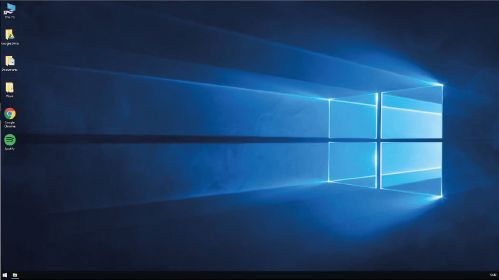
If you need to keep your desktop well organised, you can use the following guidelines:
- good practice is to use the desktop as a temporary storage area and do not copy, move or store files here for a long time.
- create shortcuts on your desktop to your applications and folders.
- delete application shortcuts that are not used.
MANAGING FILES AND FOLDERS
File management on a computer is similar to filing documents in a filing cabinet. A filing cabinet is used to store paper files in cardboard folders. In the same way, we can store files and folders on a computer electronically.
The figure below shows the ‘This PC’ folder with the sub-folders ‘Music’ and ‘Playlists’. These folders contain files that are organised according to the name of the folder. This is to give you an idea of how file management looks on a computer. In a Windows program, folders are used to organise files.
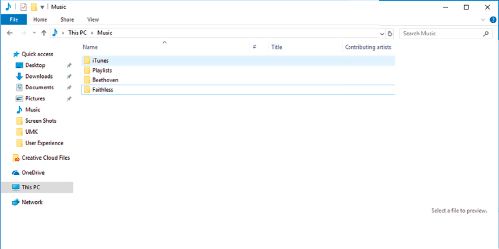

EXPLAINING COMPUTER FILES AND FOLDERS
Folders are stored on a drive in a computer. A disk drive is an important component that helps you store and retrieve data from the computer. Each drive will indicate the type of storage, this was discussed in Chapter 2, as well as directory trees and some aspects of file management.
GENERAL HOUSEKEEPING TASKS
1.DISK-CLEAN-UP
- Disk clean-up is a computer maintenance utility designed to free-up storage space on a computing device. It safely identifies and removes temporary files that are no longer needed in order to free up storage.
2.SCHEDULING AND UPDATING
- You can use a task scheduler to create and manage common tasks that your computer will carry out automatically at a time you specify, for example, you can schedule your computer to run a software update or make a backup at a specific time.
3.ARCHIVE AND BACKING-UP
- Archiving is the process of moving data that is no longer actively used to a separate storage device for long-term retention, however, this data is not duplicated. Archived data consists of old data that remains important and is retained for future reference.
- Creating a back-up is the process of making copies/duplicates of data, then storing it on a different device in a different geographical location. You are then able to retrieve the data in the event of the data on your PC being lost or destroyed.
4.COMPRESSION AND DECOMPRESSION
- File compression is a process that makes use of advanced algorithms and mathematical formulae to decrease the amount of disc space used by big files.
- Decompressing a file is a method used to extract the compressed file back to its original form and size using the same algorithms or mathematical formulae.
5.SECURITY FEATURES
- A firewall is a network utility that prevents unauthorised network connections to and from your computer. This means that only the applications you allow on your computing device can send or receive data from and to the internet.
- Antivirus is a software programme that is designed to prevent, search, detect and remove malicious software (Malware) from your computing device.
- Control of Spyware – Spyware is a piece of code that hides on your computer and tracks all your activity without your knowledge. You can control Spyware by activating the pop-up blocker on your browser settings or by installing an anti-spyware software application.
- Adware is a type of Malware that presents unwanted advertisements to the user in the form of pop-up or an ‘unclosable window’.

DATA COMPRESSION AS FAST AS POSSIBLE
6.INSTALLING AND UNINSTALLING SOFTWARE
- All installed applications used on your computing device are managed by the operating system. These applications may be used to view images, play videos or run tasks on your computing device. There are different ways of installing software: custom and default installations.
- A custom installation will allow you to see and select parts of the software you want to install.
- A full installation (default) will select all parts of the software and install it on your computing device.
- Some applications may give you a unique product key or activation code once you purchase the application. The installer will then request this product key before allowing you to install the application.
7.DEFRAGMENTATION
The disk defragmenter is a built-in utility in Microsoft Windows. When you have been installing and uninstalling applications over time, as well as creating an deleting files, the files on your computer can become fragmented. Files are not stored in one piece, but are broken up into segments of a specific size. When the disk starts running out of space, the parts of a file can not be stored next to each other on the hard disk. Instead they are stored wherever there is a space available. When you want to open the file it will take time to read the bits of the file from the fragmented locations on the hard disk.

HOW TO UNINSTALL PROGRAMS
SYSTEMS SETTINGS AND PROPERTIES
- Regional settings: Your Microsoft Windows regional settings will influence how your date/time, numeric, and currency data types appear when you apply formatting options. Click on the Formats tab under Current format.

- Language settings: To access your language settings, click Language, then Region. Then click Regional and Language Options. The Regional and Language Options dialog box will appear.
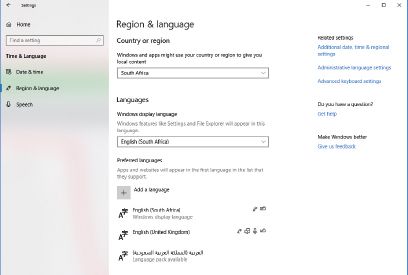
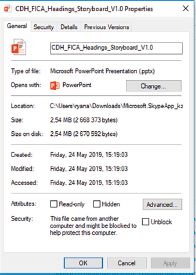
- In general, properties are the settings of an object on a computer. For example, you could right-click highlighted text and view the properties of that text. The properties of a font or text could be the font size, font type, and colour of the text.
 Activity 7.1
Activity 7.1
7.1.1The directory system of a computer is an inverted tree. Explain what this means.
7.1.2Draw an example of a hierarchical tree using the file and folder structure on your own computer. Show how you would address a particular file in the structure you have drawn.
7.1.3Explain how this hierarchical structure makes it easier to store a file on the computer so that it does not get lost.
7.1.4Sometimes we forget the ‘obvious’ folder that we stored a file in. What tool is provided in order that we may find it?
7.1.5Looking at the picture answer the following questions.
Note: Do not use the ‘Find a setting’ search option.
a.What does the image show?
b.If you want to change your password, where would you go?
c.Where would you go to increase the text size of applications on your computer?
d.Where would you go to change the time on your computer?
e.Where would you go to uninstall a program?
f.If you wanted to change your firewall’s setting where you would go.
g.Where would you go to change the brightness of your screen?
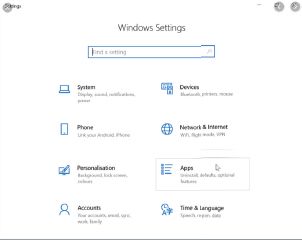
7.1.6Work on your own to answer the following questions.
a.Name three locations where you can change your system settings in Microsoft Windows 10.
b.What is the difference between these locations?
c.Which method will you use to change your system settings? Why?
7.1.7There are four housekeeping activities that are necessary to keep your computer working efficiently. Answer the following for each housekeeping activity:
a.Name the process.
b.Describe how to invoke the process.
c.Describe what it does.
d.Why is this necessary?
CONSOLIDATION ACTIVITY Chapter 7: Computer management
1.Which of the following is NOT a system you can use to change your computer’s settings:
a.Control panel
b.Properties
c.Search
d.Windows settings
2.Which of the following is NOT a good reason to delete a file:
a.It is large
b.It is redundant
c.It is not needed
d.It is infected with a virus
3.Which of the following programs can be uninstalled if your computer’s hard drive is full:
a.The operating system
b.Pre-installed software
c.Antiviruses
d.Applications you installed
4.If software on your computer stops working properly, which of the following could fix it:
a.Uninstalling the program
b.Updating the program
c.Defragmenting the hard drive
d.Installing a driver
5.Which of the following is NOT a technique that can be used to backup data:
a.Using Windows Backup
b.Copying files to a memory card
c.Using Cloud storage
d.Moving files to an external hard drive
6.When Philip connected his new keyboard to his laptop, it did not want to work. What do you think the problem is?
a.He needs to install its drivers manually.
b.He needs to free up space on his computer.
c.He needs to change his system settings.
d.He needs to scan it with his antivirus.
7.When copying and pasting files from a computer to create a backup, which of the following can be done:
a.Delete the original files.
b.Copy the files on the computer’s hard drive.
c.Organise the files on the external storage.
d.Move the files to external storage.
8.Indicate if the following statements are ‘True’ or ‘False’. Choose the answer and write ‘true’ or ‘false’ next to the question number. Correct the statement if it is FALSE. Change the underlined word(s) to make the statement TRUE where necessary.
a.The Disk clean-up tool can be used to delete files manually.
b.Defragmentation is when the parts of a program are not stored next to each other.
c.Archiving can be used to reduce the size of a file.
d.Adware is usually installed on your computer when you do a custom installation.
e.Uninstalling an application removes it and its files from your computer.
9.Choose a term/concept from COLUMN B that matches a description in COLUMN A. Write only the letter next to the question number (e.g. 1– A)
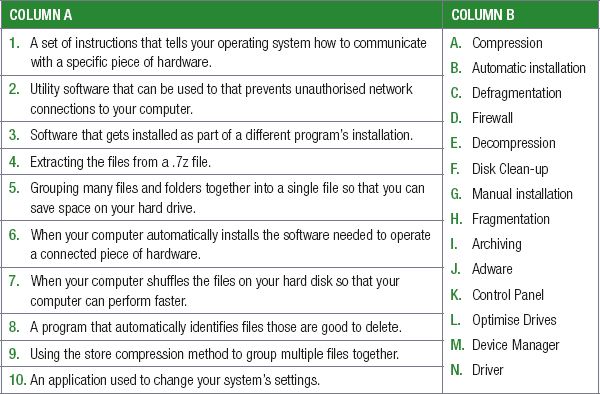
11.Give an example of a tool that can remove adware.
12.Explain how you activate your firewall.
13.List THREE types of hardware you can create backups on.
14.Waldo is a graphic designer and has recently bought a new Desktop PC. Since he creates content for many important clients, Waldo must make sure that he creates a management system that allows him to manage, protect, and control his computer and its files.
a.Mention TWO things Waldo can do to make sure he can locate files on his computer easily.
b.Waldo does not have much space on his hard drive as he does not do any housekeeping tasks. List and describe four ways he solve this problem.
c.Suggest THREE things Waldo can do protect his clients’ work from cybercriminals.
d.How regularly do you think Waldo should make backups? Give TWO reasons for your answer.
e.Waldo tells his friend that he is going to defragment his hard drive to gain disk space. Criticise this statement.
f.Waldo employs a new assistant that has problems reading text clearly. Where can he go to adjust the settings on the computer to assist the new employee.
g.Waldo only has a little bit of money left over from his computer budget. What should he rather spend money on – a good anti-virus system or a firewall? Substantiate your choice.
|
Previous
Chapter 6: Electronic communications
|
Table of Contents |
Next
Chapter 8: The internet and the world-wide web
|




